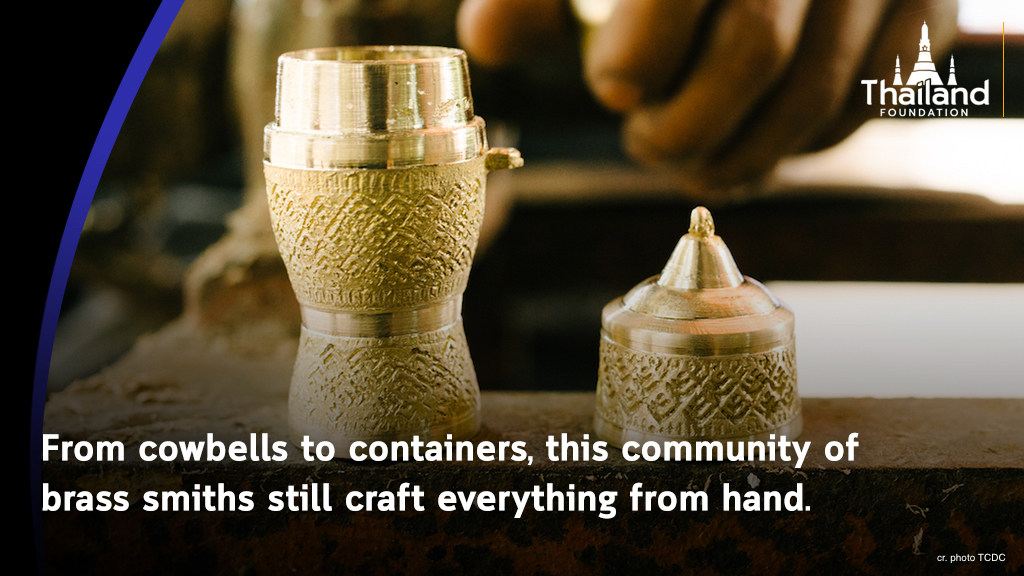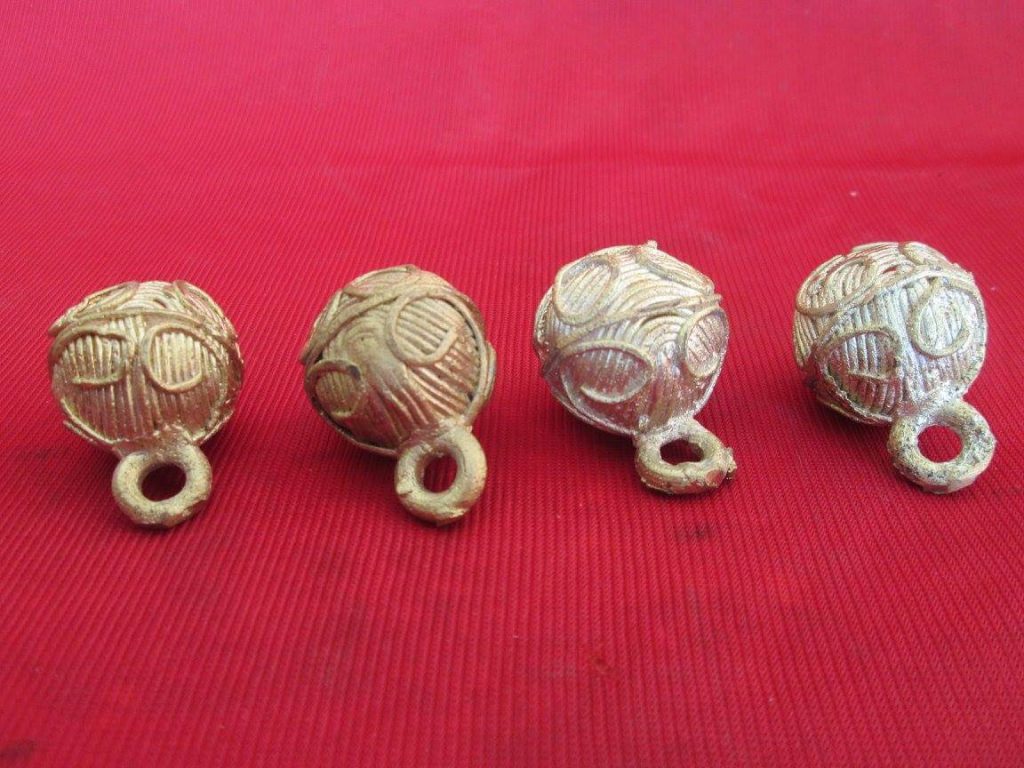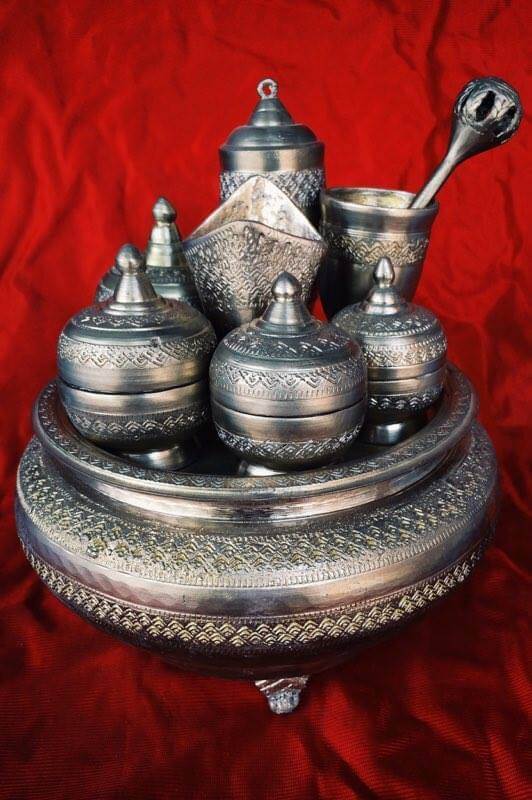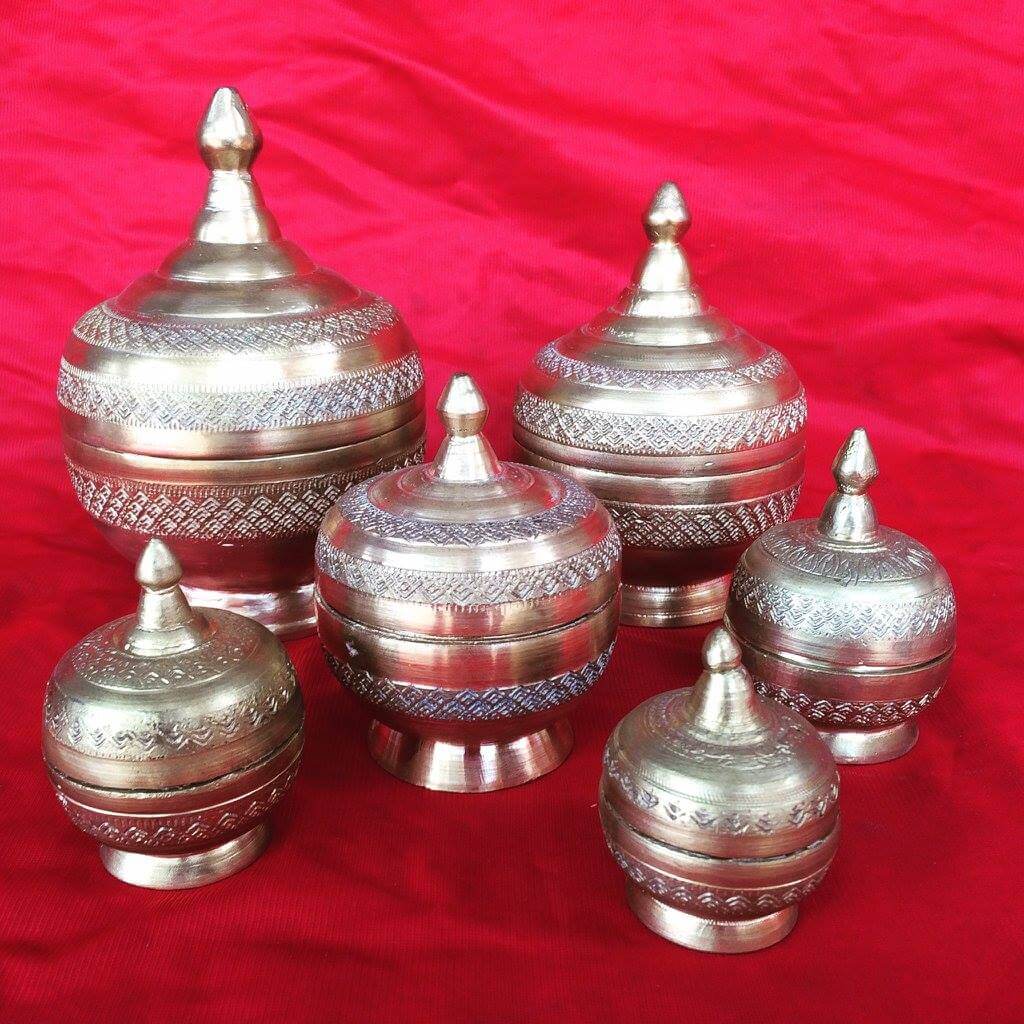Baan Pa Ao Brass Craft

“Brass craftsmanship seems to be easy, but really it is anything but. Because of the delicate nature that the finished product demands, only those who are truly passionate and patient can pursue it as a career,” said Mr. Suthep Ruamruk, a sixth-generation practitioner of Baan Pa Ao Brass Craft [ทองเหลืองบ้านปะอาว]. Baan Pa Ao Brass Craft, eponymously named after a village in Ubon Ratchathani Province, is a category of crafts founded during the prehistoric time of Ban Chiang, and it is still commonly practiced today. Throughout the years, the craft has witnessed some changes, mostly to meet the demands of today’s customers, but by and large, Baan Pa Ao Brass Craft has been able to preserve its essence and authenticity. The history, processes, and the future of this craft are the central concerns of this article.
The brass craftsmanship portrays a perfect combination of arts and science: it requires elements of both metallurgy and artistry. For generations, the wisdom has been inherited, experienced, and adapted according to periodical changes.
The History of Baan Pa Ao
As aforementioned, Baan Pa Ao [บ้านปะอาว] is the name of a village in Ubon Ratchathani Province. However, there is more to the name. “Our ancestors,” said resident Mr. Boonmee Lormwong, “came from Nong Bua Lamphu Province during the reign of Thao Khampong. The ancestors before that had migrated from Vientiane, led by Phra Wo and Phra Ta. After some unrest, a descendent of Phra Wo — Thao Khampong — fled with the people to settle at Huay Jaramae, an area of Ubon Ratchathani Province. Migrating with Thao Khampong were two brothers, Pho Khun Yai and Pho Khun Lek, who later separated with the group in search of a settlement elsewhere. After settling down, Pho Khun Yai left the land to his younger brother. ‘Pa Ao’ is the northeastern Thai dialect phrase meaning ‘leave the younger brother’. The older brother, afterwards, moved to Baan Phone Mueang, Muang Sam Sip District of Ubon Ratchathani Province.”

Cowbells [cr. FB: OTOP บ้านปะอาว ศูนย์อนุรักษ์หัตถกรรมหล่อทองเหลือง]
In the past, Baan Pa Ao craftsmen manufactured mostly lime kilns, metal tubes, drums, bells, and water bowls. Now, they are also making betel boxes, ewers, vases, candle holders, and trays for use during worship and at ceremonies. These newer products are more demanded. Signature patterns of Baan Pa Ao are lotuses, fish roes, and traditional patterns, such as “Mak wai” and “Luk kling” — traditional geometric designs. However, the craftsmen are also coming up with new patterns to keep up with the times.
For centuries, before brass craft boomed, the lives of Baan Pa Ao villagers revolved around agriculture, especially rice farming. Brass craft was treated as a side career. In their free time, villagers would prepare materials and equipment needed to make the brass craft, carrying their crucibles into the woods once a year, when casting was done as seldomly as that. (The advantage of the woods was that it was where firewood could be easily procured.) When they were done, the villagers would carry or wheel buffalo-drawn wagons with their products into town, selling the brassware to shops and households. Only later did they begin to work from the tai tun, a traditional Thai basement, of their homes. (The “basement” here refers to a wall-less, well-ventilated ground floor area of traditional Thai stilt architecture.) Nowadays, most brass casting is done at the village temple.
Process of Brass Craft Production
The brass craft items of Baan Pa Ao are produced with a unique, traditional method called soon khi pueng or khi pueng hai, similar to the lost-wax process. The process uses local equipment and materials, namely anthill soil, cow dung, husk, tree sap, and wax originating from bees, including channarong (stingless bees).
In terms of equipment, there are several technical pieces, such as:
- Mon noy: a small handmade lathe whose components include:
- Hong sian or hong klueng — a pair of bent wooden sticks. They are placed on the left and right sides, holding together mai mon.
- Mai mon — a hard wooden stick used for molding. The stick is carved into a cylinder the length of the distance between the two hong sian. The end of both sides is inserted into the holes drilled into hong sian.
- Mai yiab — a stick made from hardwood, also located between the hong sian, essential when lathing the mold.
- Meed klueng or lek sian — a type of chisel made of iron or wood, which helps smooth the mold’s skin.
- Pattern stick: made of buffalo horn due to its softness and flexibility.
- Pan
- Charcoal brazier
- Pottery kiln and tongs
- Brass melting furnace and stainless-steel dipper
- Threshing basket
- Firewood

Betel nut set [cr. FB: OTOP บ้านปะอาว ศูนย์อนุรักษ์หัตถกรรมหล่อทองเหลือง]
To make the brass products, craftsmen follow the instructions below:
- Mold preparation:
- To make a mold, mix anthill soil with cow dung in a ratio of 2:1. The mixture of these materials makes the mold firm, less opaque, and easy to lathe. Also, it can expand well and withstand rupture at high temperatures. Buffalo dung can be an alternative (though it is not used widely because it is less sticky and smells strong).
- To make a mold cover, combine anthill clay with husk in a ratio of 3:1. Pound the materials in khrok mong (a huge stone mortar). The mold cover is used to cover the outer wax layer of the mold before casting.
- Mold sculpting: mold the mixture in step 1.1 into the desired shape. Pierce through the mold’s diameter with mai mon and dry it in the sun. After the mold is dry, shape it with the lathe.
- Beeswax preparation: mix beeswax and tree sap. Boil all ingredients together in a pan and let it cool down in a tray.
- Beeswax rolling: warm up the wax made in Step 3 until soft and put it in a bang diak (a bamboo press, which yields thin brass strips). It is important to grill the bang diak before filling the wax. The bang diak core, made of iron, can conserve heat, keeping the wax soft inside. To pump out the wax strings, push the plunger and sway the barrel simultaneously. Prepare the strings on the threshing basket for wax coating.
- Beeswax coating: roll the wax strings around the whole mold. Singe the wax to soften and lathe the surface until smooth.
- Pattern-printing: press the pattern stick on the mold to create desired details. Soak the pattern stick before using to prevent the wax from sticking.
- Mold-coating: combine the anthill clay with cow dung and a small portion of water. Cover the wax-coated mold with blended elements and make a small tube protruding from the mold for pouring brass.
- Double-coating: double-cover the mold with the mixture in step 1.2 and make a base wide enough to set the workpiece in an upright position. Dry the work in the sun.
- Mold heating: heat up the mold at approximately 700 degrees Celsius in a pottery kiln until the wax melts.
- Mold flipping: Bring the mold out and flip it upside-down. Let the melted brass drain out through the tube.
- Brass casting: melt the brass at a temperature of 1,000 degrees Celsius. Fill up the mold with melted brass and wait about 20 minutes, or until the brass cools down. Crack the work out of the mold.
- Decoration: lathe, decorate and polish the work.
The brass work is ready for use or sale.
The Future of Baan Pa Ao Brass Craft

Containers [cr. FB: OTOP บ้านปะอาว ศูนย์อนุรักษ์หัตถกรรมหล่อทองเหลือง]
At present, Baan Pa Ao Brass Craft faces waning popularity, which call for revisions and adaptation. Today, Baan Pa Ao has about 30 brass craftsmen, and most are only casual workers.
“Those [30 people] are every one of us from the sixth generation. I have no clue how many people will join the seventh because the work requires dedication and precision. The young generation prefers jobs that are less time-consuming, where they can earn more money quickly. Yet, I am so grateful to be part of this great family. The rest is really up to them,” said Mr. Thongkham Prathummas, a craftsman, while his hands cupped a mold.
As we continued to chat, thunder and rain rolled in. “Well, it is what it is. I’ve still got a lot of drying to do,” Boonmee Lormwong, another craftsman, laughed as he left to move his elaborate art pieces under shelter.
The rainfall signaled a new season, a new beginning. Still, what tomorrow holds for the new generation of Baan Pa Ao craftsmen is still unknown.
**************************
Reference
พัทธนันท์ โอษฐ์เจษฎา. “หัตถกรรมเครื่องทองเหลืองบ้านปะอาว” Watthanatham Journal: Department of Cultural Promotion, yr. 54, no. 4, October – December. 2015, pp. 26 – 32. Retrieved April 1, 2021. Link


